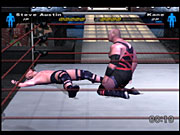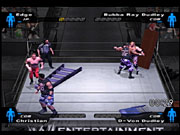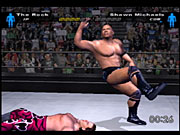Of all of THQ's current WWE franchises, the SmackDown! series has been around the longest. Originally debuting on the PlayStation back in the year 2000, SmackDown! was the first wrestling venture from developer Yuke's. The game provided a faster pacing and style of wrestling gameplay than the other World Wrestling Federation developer, Aki Corporation, and, while some criticized the initial SmackDown! title for this fact, over the years it has matured into the market's definitive WWE wrestling series. A mere four years after SmackDown!'s debut, Yuke's and THQ have brought to the table WWE SmackDown! Here Comes the Pain, the fifth iteration of the series. Here Comes the Pain isn't any sort of significant leap forward for the franchise, as many of the same basic mechanics found in last year's SmackDown! Shut Your Mouth are back once again. What the game lacks in innovation, however, is more than made up for in sheer playability.

Though much of the time-tested SmackDown! gameplay system has been left untouched this year, one big change has come in the form of the game's new grappling system. Grappling is a function that last year's Shut Your Mouth began to overhaul a bit, but Here Comes the Pain completely renovates the game's grappling functionality. The new system actually contains four different grappling types; they are: submission, quick, power, and signature. The way the system works is that each category is designated by a direction on the directional pad or analog stick. So, for instance, to perform a signature grapple, you would press the stick or D pad to the left and hit the grapple button at the same time. Doing so will lock up your opponent with a category-specific animation. Once you're locked up, you'll then press a direction on the stick/pad again, along with the grapple button, and then you'll perform the move. While this may seem a bit long-winded for the game's generally fast pace, it actually works pretty well. The transition animations between sequences are excellent in keeping the action moving, and the actual timing of the moves has to be pretty quick. Plus, with this system in place, you have at your disposal 16 different grappling moves per wrestler.
Aside from the grappling system, a couple of other key areas of the gameplay have gotten upgrades as well. Here Comes the Pain features a new, location-specific damage system. At the top of the screen, near your SmackDown! meter, an icon appears that shows an outline of a human body. Whenever damage is inflicted on a specific area of a wrestler, like the legs, arms, head, and/or torso, the icon will flash in the appropriate area. As you continue to work on a certain area of your opponent, that area will reflect more damage by turning yellow, orange, and eventually red. These icons give you a better idea of where you should focus your attacks and are especially helpful when locking-in submission holds. Here Comes the Pain also features an updated version of last year's reversal system. While, fundamentally, reversals work much the same way, you aren't limited to a single reversal button for gameplay. Reversals are now split up between two buttons; there's one for strikes and one for grapples. Pressing the correct button in tune with your opponent's attacks will frequently allow you to reverse an attack. This eliminates much of the guesswork from last year's grappling system, and, ultimately, it works much, much better. Reversals also look even better than ever before and transitioning between moves is as smooth as smooth can be.
Here Comes the Pain is loaded with nearly every type of conceivable match you could think of. When selecting exhibition mode, you'll be presented with a bevy of options, including single, tag, six-man tag, handicap, hardcore, royal rumble, survival, and main event matches. Main event matches are the most gimmicky type of matches and include such favorites as TLC, first blood, hell in a cell, ironman, lumberjack, special referee, cage, three stages of hell, and two new additions to WWE games, the elimination chamber and bra and panties matches. Bra and panties is a women's only match where the ultimate goal is to strip your opponent down to her unmentionables. The elimination chamber is a six-man elimination match, held within a monolithic cagelike device with four isolation casings held within. The match begins with two wrestlers going at it in the ring, as per usual, while the remaining four are each held within one of the glass isolation chambers. After a period of time elapses, one isolated wrestler will be released into the fray. Eventually, all the wrestlers will be released, and the last wrestler to survive is the winner. These new matches are very well done, and you should have a blast with them.

While all of these matches are great, the biggest draw has to be Here Comes the Pain's season mode. Very similar to last year's season mode, here you can opt to take any of the WWE superstars, or one of your own created wrestlers, through the many trials and tribulations a wrestler would face when competing in the WWE. At the beginning of the mode, you start by choosing which show you want to appear on--Raw or SmackDown!--and have the option of shuffling the rosters of each show to your liking. Once that task is complete, you are then taken to a cutscene where you'll see your wrestler walking around inside the ring, surrounded by an empty arena. He'll talk for a bit about why he does this night in and night out, and he laments about how he ultimately seeks to find himself through competition. You'll then encounter your general manager (either Eric Bischoff or Stephanie McMahon, depending on which show you choose), who gives you some words of encouragement. After that, it's off to the locker room.
The locker room is the central "hub" area for the season mode. Here, you have multiple options at your fingertips, including match, shopzone, move, attributes, profile, and stable. The move function effectively replaces last year's free-roaming movement around event arenas, and it, instead, gives you the option of simply jumping to one location or another, like the arena back entrance, the parking lot, the training room, the corridor, and/or the general manager's office. You can only travel to these locations if another wrestler currently occupies that space as well. So, for example, if Kurt Angle is standing around in the parking lot, you can go talk to him. Any number of things can happen from here, ranging from a simple conversation to a challenge for a match. The general manager's office is the only area that is consistently available from show to show, and here you can request title shots, a transfer to the opposing TV program, and you can also check on your superstar's status.

Shopzone is a new mode in SmackDown!, and it offers a similar design to the shopzone mode found in WWE Wrestlemania XIX for the GameCube. The mode houses all of the game's unlockable items, which you can purchase using SmackDown! cash. Cash is earned by winning matches in the season mode, and there is a pretty nice list of things you can get, including moves for the create-a-wrestler mode, extra arenas, more wrestler attire, and unlockable wrestlers, including such classic wrestlers as the "Million Dollar Man" Ted Dibiase, Jimmy "Superfly" Snuka, Sgt. Slaughter, and the Legion of Doom, featuring Hawk and Animal. Cash isn't the only thing you'll earn during matches, however, as you'll also gain experience points through each match you participate in. These experience points can be used in the attributes section of the locker room to improve your wrestler's stats in categories like submission skill, strength, speed, endurance, and technique.
With regard to the season mode's storylines, they aren't altogether different from last year's title in terms of design. In fact, a couple of sections actually seem like repeats from the previous game. There are many new storyline sections, however, and you'll be able to take part in a number of different plots, including tag team battles with a less-than-willing partner and a section where you'll be able to start your very own faction. The same exact style of cutscene work from last year is used in Here Comes the Pain as well, but there's also some nice new, little touches, like black and white video montages that play before pay-per-views to highlight the culmination of your current feud. There are some quirks here and there, like small sections that don't really make a ton of sense in terms of storyline continuity and areas where there's a bit of repetition in your selection of opponents throughout the season. Overall, though, it's a great season mode and every bit as worth playing through as last year's.
The one feature in Here Comes the Pain that has probably seen the least change is the create-a-wrestler, which, for all intents and purposes, is the same create-a-wrestler from Shut Your Mouth. All of the same abilities are there in terms of appearance editing, with loads of options for body forms, facial attributes, and costume options. Your wrestler's sway with the crowd (face or heel), his or her personal profile, attributes, CPU logic, basic entrance features, and full-move sets are also editable. The create-an-animation mode is similarly untouched, with all the same editable functions but with more options overall. Despite the fact that it's so much like its predecessor's mode, there's still an awful lot to do with the mode, and there's no reason why you shouldn't be able to create all your favorite non-WWE wrestlers, as well as any feasible original creation. The one real disappointment is that the mode doesn't feature some of the newer options found in the Wrestlemania XIX and Raw 2 create-a-wrestlers, especially in the realm of entrances. Both Wrestlemania and Raw 2 had some great options in terms of designing camera angles, lighting schemes, entrance videos, and the like. Considering many of these new options were designed by Yuke's, it's a little baffling that these options weren't included.
Here Comes the Pain is easily the best-looking SmackDown! game ever, and, quite possibly, the best-looking WWE game ever. Every wrestler model in the game is a near-perfect representation of his or her real-life counterpart, right down to the smallest facial and body detail. Take a close look at the models for wrestlers like The Rock or Chris Jericho, and you will be amazed at just how lifelike they actually look. Each wrestler animates equally superbly. Every single move in the game looks great and looks just as incredibly painful as you would hope. The various wrestling arenas are all about what you've come to expect from the SmackDown! series, sporting excellent, detailed set designs and loads of polish. The various backstage areas are equally impressive, with lots of destructible elements and plenty of weapons strewn about. The game isn't perfect looking by any means, as clipping issues still exist--though far less than in the more recent Wrestlemania and Raw titles--and some of the wrestler's hairstyles just don't look quite right. All told, it's a fantastic looking game though.
Although Here Comes the Pain actually doesn't have commentary of any kind, in a way, that's somewhat of a blessing. The commentary provided by Jim Ross and Jerry Lawler in previous SmackDown! titles has been lacking, at best, and not having to hear their listless, generally inaccurate comments makes the in-ring action a lot more pleasant. It is kind of unfortunate, though, that THQ's solution to fixing the commentary was removing it altogether rather than trying to actually improve it. The rest of the game's audio presentation is pretty good, featuring nearly all the wrestler's appropriate theme songs, some decent background music during matches and menu screens, and a nice array of slams and sounds for weapons cracking against opponents. Still, it seems as though, year in and year out, whatever improvements are made to SmackDown!'s sound presentation, they're never much of a leap forward, and this year's game does even less improving than any of its predecessors.

In the end, WWE SmackDown! Here Comes the Pain is a fantastic wrestling game through and through, despite its lack of innovation. You could nitpick on and on about how one thing or another isn't different enough from last year's SmackDown!, and, honestly, you'd be right in your observations. Really, though, no amount of nitpicking can take away from the fact that Here Comes the Pain is still the best WWE game on the market today, thanks to its well-executed season mode, great create-a-wrestler, and significantly deeper grappling system that, really, is one of the best ones ever put into a wrestling game. Any fan of previous entries in the SmackDown! series should absolutely not hesitate to give Here Comes the Pain a try, as it is truly the best one yet.